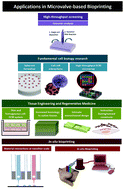Microvalve-based bioprinting – process, bio-inks and applications
Abstract
Bioprinting is an emerging research field that has attracted tremendous attention for various applications; it offers a highly automated, advanced manufacturing platform for the fabrication of complex bioengineered constructs. Different bio-inks comprising multiple types of printable biomaterials and cells are utilized during the bioprinting process to improve the homology to native tissues and/or organs in a highly reproducible manner. This paper, presenting a first-time comprehensive yet succinct review of microvalve-based bioprinting, provides an in-depth analysis and comparison of different drop-on-demand bioprinting systems and highlights the important considerations for microvalve-based bioprinting systems. This review paper reports a detailed analysis of its printing process, bio-ink properties and cellular components on the printing outcomes. Lastly, this review highlights the significance of drop-on-demand bioprinting for various applications such as high-throughput screening, fundamental cell biology research, in situ bioprinting and fabrication of in vitro tissue constructs and also presents future directions to transform the microvalve-based bioprinting technology into imperative tools for tissue engineering and regenerative medicine.



 Please wait while we load your content...
Please wait while we load your content...